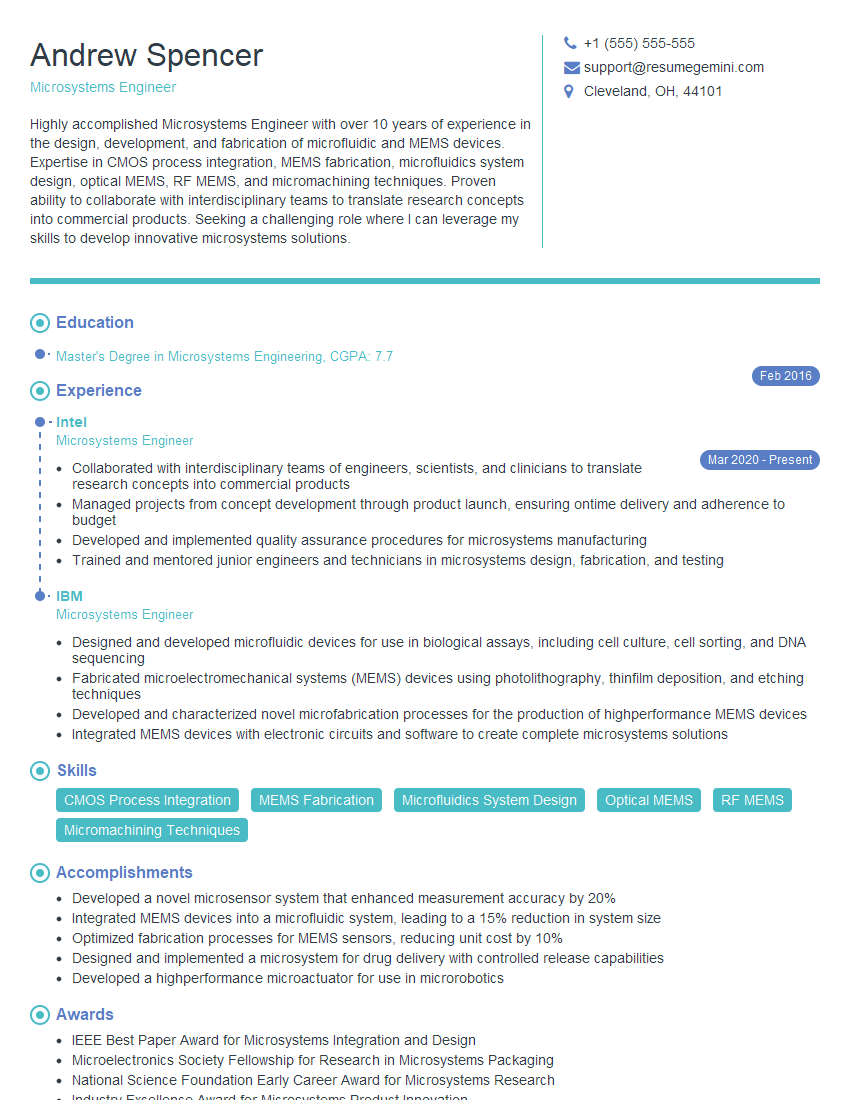Are you a seasoned Microsystems Engineer seeking a new career path? Discover our professionally built Microsystems Engineer Resume Template. This time-saving tool provides a solid foundation for your job search. Simply click “Edit Resume” to customize it with your unique experiences and achievements. Customize fonts and colors to match your personal style and increase your chances of landing your dream job. Explore more Resume Templates for additional options.

Andrew Spencer
Microsystems Engineer
Summary
Highly accomplished Microsystems Engineer with over 10 years of experience in the design, development, and fabrication of microfluidic and MEMS devices. Expertise in CMOS process integration, MEMS fabrication, microfluidics system design, optical MEMS, RF MEMS, and micromachining techniques. Proven ability to collaborate with interdisciplinary teams to translate research concepts into commercial products. Seeking a challenging role where I can leverage my skills to develop innovative microsystems solutions.
Education
Master’s Degree in Microsystems Engineering
February 2016
Skills
- CMOS Process Integration
- MEMS Fabrication
- Microfluidics System Design
- Optical MEMS
- RF MEMS
- Micromachining Techniques
Work Experience
Microsystems Engineer
- Collaborated with interdisciplinary teams of engineers, scientists, and clinicians to translate research concepts into commercial products
- Managed projects from concept development through product launch, ensuring ontime delivery and adherence to budget
- Developed and implemented quality assurance procedures for microsystems manufacturing
- Trained and mentored junior engineers and technicians in microsystems design, fabrication, and testing
Microsystems Engineer
- Designed and developed microfluidic devices for use in biological assays, including cell culture, cell sorting, and DNA sequencing
- Fabricated microelectromechanical systems (MEMS) devices using photolithography, thinfilm deposition, and etching techniques
- Developed and characterized novel microfabrication processes for the production of highperformance MEMS devices
- Integrated MEMS devices with electronic circuits and software to create complete microsystems solutions
Accomplishments
- Developed a novel microsensor system that enhanced measurement accuracy by 20%
- Integrated MEMS devices into a microfluidic system, leading to a 15% reduction in system size
- Optimized fabrication processes for MEMS sensors, reducing unit cost by 10%
- Designed and implemented a microsystem for drug delivery with controlled release capabilities
- Developed a highperformance microactuator for use in microrobotics
Awards
- IEEE Best Paper Award for Microsystems Integration and Design
- Microelectronics Society Fellowship for Research in Microsystems Packaging
- National Science Foundation Early Career Award for Microsystems Research
- Industry Excellence Award for Microsystems Product Innovation
Certificates
- Certified MEMS Engineer (CME)
- Certified Microsystems Professional (CMP)
- Six Sigma Green Belt
- ISO 9001:2015 Quality Management
Career Expert Tips:
- Select the ideal resume template to showcase your professional experience effectively.
- Master the art of resume writing to highlight your unique qualifications and achievements.
- Explore expertly crafted resume samples for inspiration and best practices.
- Build your best resume for free this new year with ResumeGemini. Enjoy exclusive discounts on ATS optimized resume templates.
How To Write Resume For Microsystems Engineer
- Highlight your expertise in the design and fabrication of microfluidic and MEMS devices.
- Showcase your experience in CMOS process integration and other relevant microfabrication techniques.
- Quantify your accomplishments and provide specific examples of how you have contributed to the success of projects.
- Emphasize your ability to collaborate effectively with interdisciplinary teams and manage projects from start to finish.
Essential Experience Highlights for a Strong Microsystems Engineer Resume
- Designed and developed microfluidic devices for use in biological assays, including cell culture, cell sorting, and DNA sequencing.
- Fabricated microelectromechanical systems (MEMS) devices using photolithography, thin-film deposition, and etching techniques.
- Developed and characterized novel microfabrication processes for the production of high-performance MEMS devices.
- Integrated MEMS devices with electronic circuits and software to create complete microsystems solutions.
- Collaborated with interdisciplinary teams of engineers, scientists, and clinicians to translate research concepts into commercial products.
- Managed projects from concept development through product launch, ensuring on-time delivery and adherence to budget.
- Developed and implemented quality assurance procedures for microsystems manufacturing.
Frequently Asked Questions (FAQ’s) For Microsystems Engineer
What is the role of a Microsystems Engineer?
Microsystems Engineers design, develop, and fabricate microfluidic and MEMS devices for use in a variety of applications, including biomedical, environmental, and industrial.
What are the key skills required for a Microsystems Engineer?
Key skills for Microsystems Engineers include expertise in CMOS process integration, MEMS fabrication, microfluidics system design, optical MEMS, RF MEMS, and micromachining techniques.
What are the career prospects for Microsystems Engineers?
Microsystems Engineers are in high demand due to the growing use of microfluidic and MEMS devices in a wide range of industries. Career prospects are excellent for qualified candidates.
What is the average salary for a Microsystems Engineer?
The average salary for a Microsystems Engineer in the United States is around $100,000 per year.
What are the educational requirements for a Microsystems Engineer?
Most Microsystems Engineers have a Master’s degree in Microsystems Engineering or a related field.